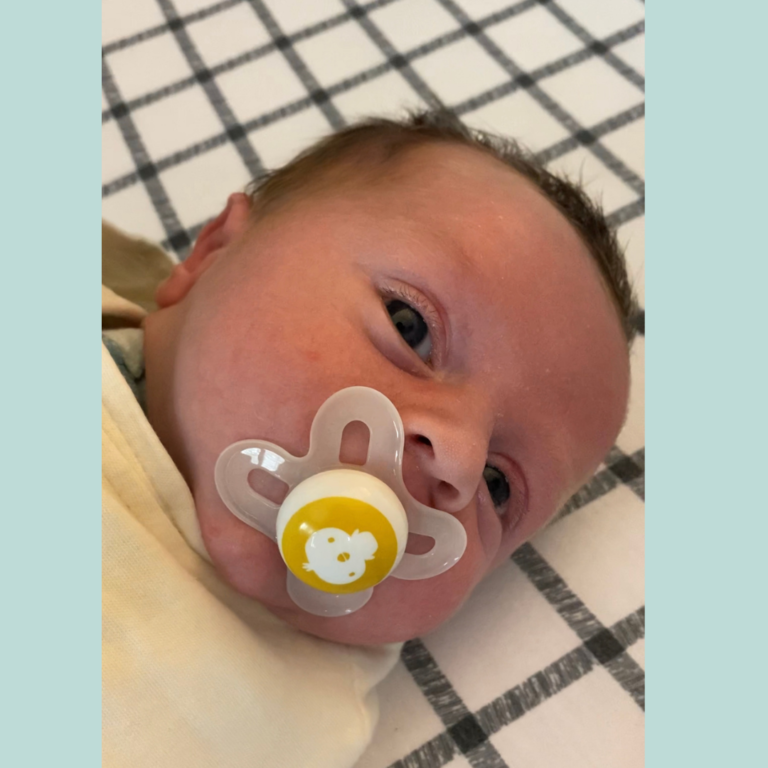Daylight Savings Time: How to Adjust Baby Sleep Schedule to Spring Forward
For many parents, Daylight Savings time changes can feel like cruel and unusual parenting punishment! Twice a year we have to reevaluate our always-dynamic child’s schedule to make adjustments for a shift forward or back. The good news is that “Springing Forward” tends to be an easier transition than “Falling Back.” Read on for ways to adjust your baby’s schedule for daylight savings time.
What Does Daylight Savings Time mean for your sleep schedule?
It means a later wake-up time by the clock on Sunday morning but still feels like your usual wake-up time. Some parents look forward to this transition if they have an early riser in the house (think 6 a.m. wake up now becomes 7 a.m. YAY!!!)
Although this may work for some families, others require some preparation to maintain the same schedule for work, daycare, and school purposes!
Sleep Science-Circadian rhythm
Sleep is regulated by our circadian rhythm which is run by light and dark. With any time transition, exposing your Wee One to natural light in the early morning and afternoon can help with the time adjustment.
Play outside, go to the park, anything to get outside and expose your family to natural light during the day will help with melatonin (sleepy hormone) production at night.
This is the season when Blackout shades become important for the evening as well. With the sun setting at a later time, your Wee One’s bedroom may not be as dark in the evening. Make sure you invest in a good pair. My favorite Blackout shades are from Sleepout. Use code: wellrested to take 10% of their black out home or portable curtains.
So How Do You Adjust Your Baby’s Sleep Schedule to Spring Forward?
2 Options to Choose From!
If your baby was older than 6 months at the last time change, try to remember how they did with that adjustment? I know it’s hard, it’s been 6 months!! Were they a mess for a week or two, was it more of an annoyance than an issue, or did you not have any issues at all??!! This will help guide you in how to approach the time change based on your child’s temperament.
If your baby is less than 6 months old as of right now or was less than 6 months at the last time change, try to think about how they do in general with schedule adjustments. Are they an easy-going no big deal kind of baby if naps and bedtime fall at a different time OR are they more sensitive to changes!! This will help you decide which approach is a better fit for your family!
Option 1: No Prep & Adjust Schedule One Hour Later by the Clock
What Does This Mean?
It means you don’t make any adjustments to the schedule ahead of time!
If you are looking for a later wake-up time in the morning (6 a.m is now 7 a.m.) and are OK adjusting the entire daily schedule later, this can work for you if you can consistently maintain this schedule! Below are some sample schedules based on the number of naps to reference.
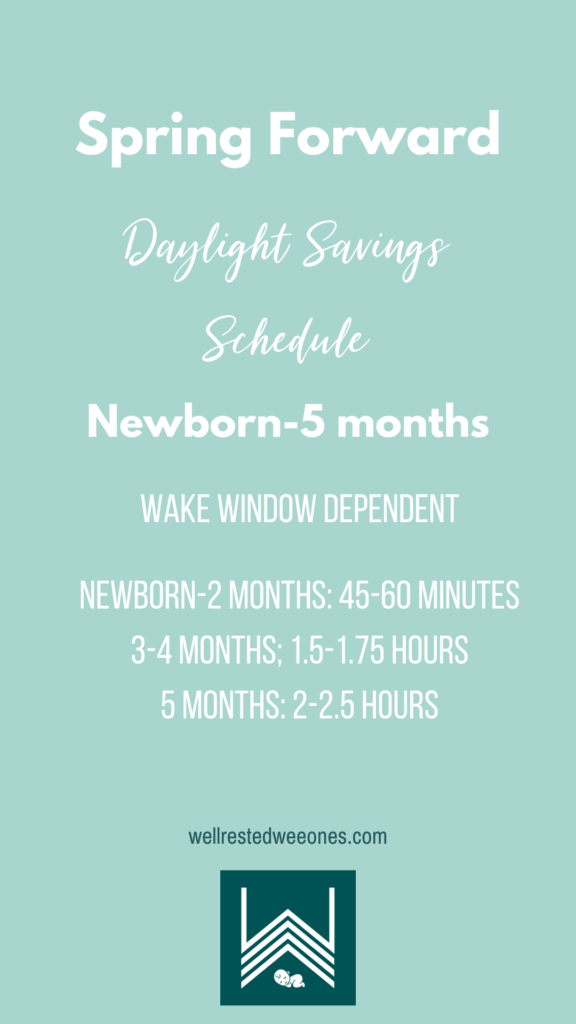
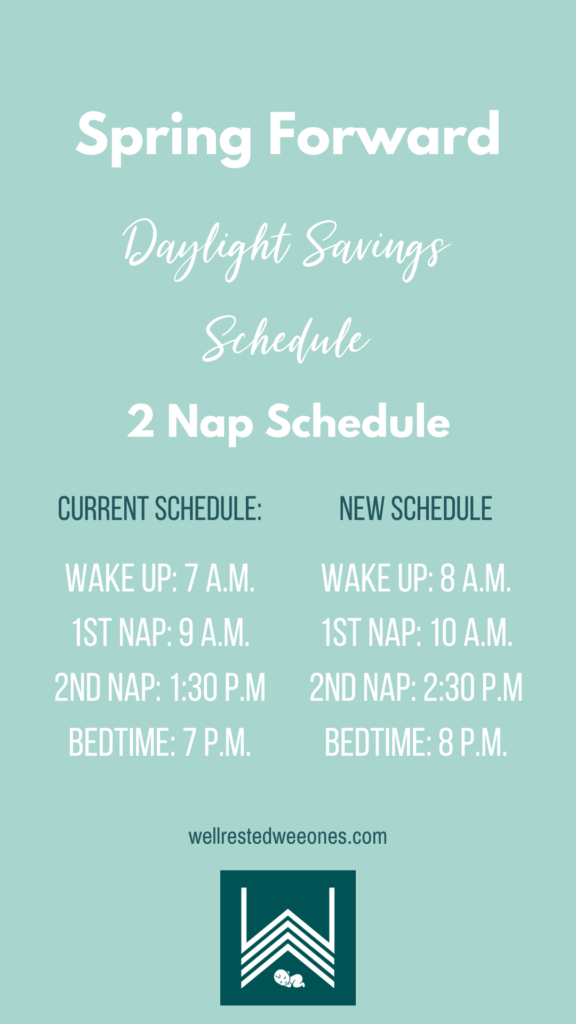
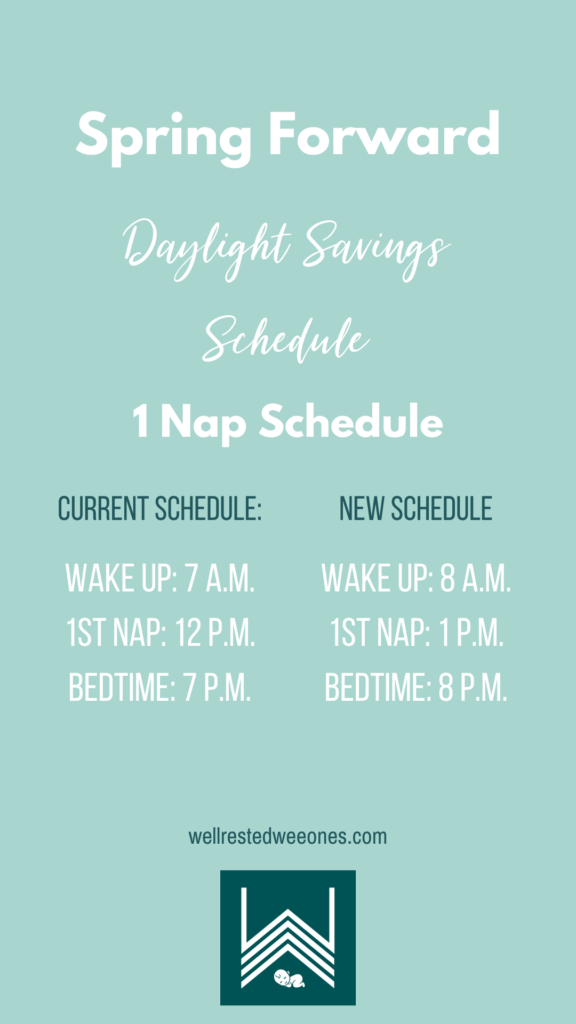
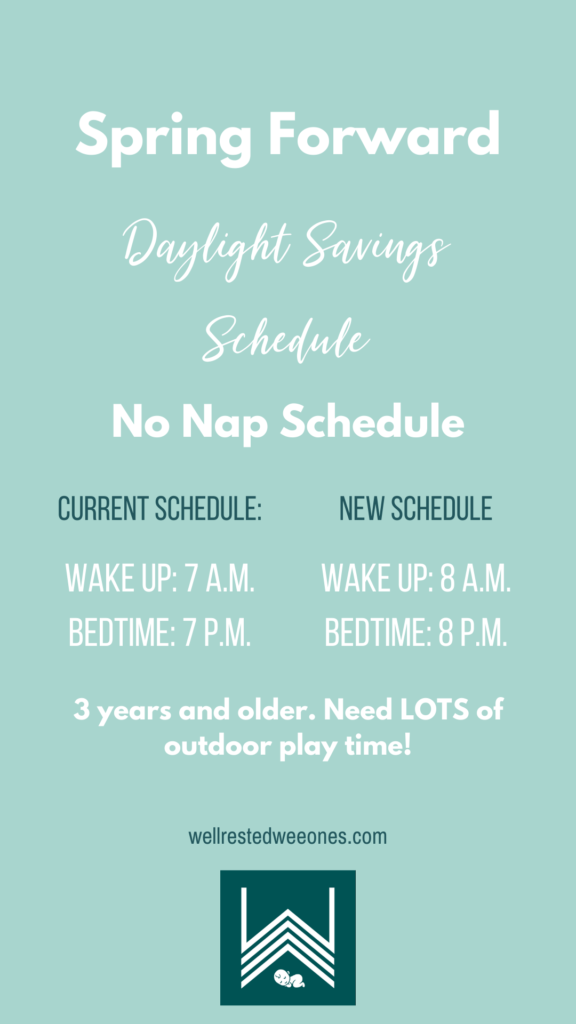
Who Is This Good For?
- Families who have a baby less than 4 months old. The schedule is still wake window dependent and bedtime is variable based on what time the last nap ended. No Need to Prep at ALL!!! Enjoy this time change!
- Families who don’t have a predictable bedtime or morning wake-up time yet. If you don’t know what time your baby is going to wake up, that makes it hard to wake them 15 minutes earlier than usual! Just ride it out!
- Families who don’t have to leave the home by a certain time in the morning. If you can let your baby sleep until 8 a.m. and are okay with the rest of the day falling later, this is good for you!
- Families that want a later wake-up time in the morning and are okay with naps and bedtime happening an hour later.
- The caveat to this–> If your child’s current bedtime is 8 p.m. prior to the time change, you do not want it to change and be at 9 p.m.!! The natural window to fall asleep for babies, toddlers, and preschoolers is between 6-8 p.m. Many will get a “second wind” after 8 p.m. which is a sign of being overtired, making it harder to fall asleep!
What Does a Schedule Look like for this Option?
If you have a newborn to 6 month old who is still on 3 naps a day, you will continue to follow wake windows as opposed to a set clock schedule! Your day will still look variable based on how long your baby napped for! If your baby is older than 6 months reference schedules below for the no-prep/maintain current schedule approach! This is a general idea of what the schedule would look if not making any adjustments! Click on these images to enlarge and save or screenshot for reference!
Option 2: Slow and Steady Prep
What Does This Mean?
It means you will start to make gradual adjustments to your child’s schedule either one week or four days before the time change to adjust their body and to maintain their current clock schedule.
Who is This Good For?
- Families who have a baby who wakes at a predictable time every day (older than 4 months)
- Families who need to leave in the morning by a certain time for work, daycare, or school
- Families who have a child that attends daycare. The first few days after a time change are notorious for being crazy at daycare! Take the time to prepare!
- Families who like how the current schedule works during the day and want to maintain the same schedule without an abrupt change
- Families who have a toddler or preschooler. This age group needs to expend A LOT of energy during the day and needs to build a certain amount of sleep pressure to fall asleep easily.
- You can’t expect to put your toddler down for bed at 7 p.m. (what feels like 6 p.m.) on Sunday night and think they are going to fall right asleep if you haven’t made adjustments. Why? Because your toddler will pull out their “To Do” list of everything they need and want and delay bedtime. This will last for a few days and you will tend to their requests and by the time they adjust to the time change, you will find yourself in a new habit of a LONG bedtime routine that is hard to escape and can result in sleep issues!
What Does a Schedule Look Like with Slow and Steady Prep?
Starting 4-7 days before the time change start adjusting your child’s schedule earlier by 15 minutes every 1-2 days.
By doing this, you will help your child maintain the same sleep pressure and drive for naps and bedtime to land at the same time after the time change. Yes, you will be waking them up earlier than usual for those days leading up to the time change, but this will result in waking your baby up at their regular clock time on Sunday morning and prepare for losing the hour of sleep without feeling overtired.
This is a general guide using a 2 nap a day schedule but could be used for a 1 or 0 nap a day schedule as well.
For a 3 nap schedule with a predictable morning wake-up time, start the day and first nap 15 minutes earlier following this pattern. For a toddler who is sporadically napping see my additional tips below!
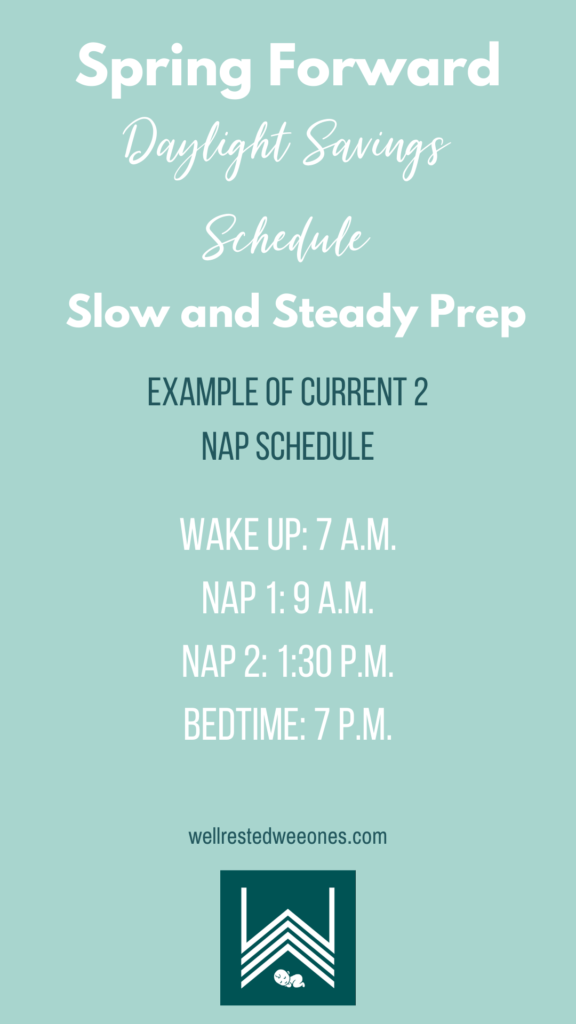
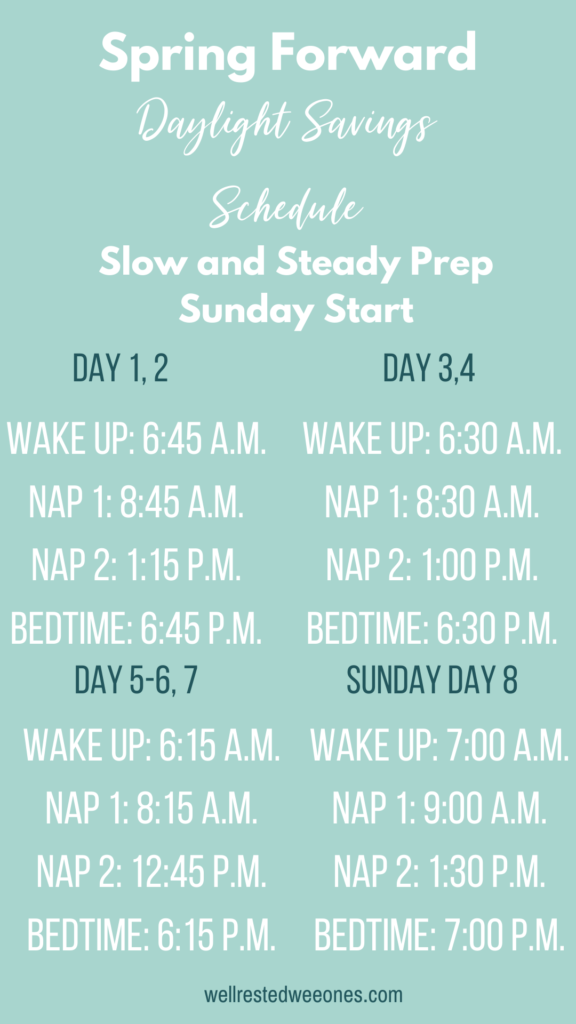

Other Daylight Savings Sleep Tips
- If your toddler or preschooler is transitioning away from naps, but still needs one a couple of days a week, strategically plan for the 3 days leading up to Sunday to skip naps and aim for an earlier bedtime.
- You can also shorten or cap a nap by 30 minutes and aim for an earlier bedtime so they still feel tired at regular clock bedtime.
- If your baby is less than 4 months old, do not stress this! Just continue to follow your wake windows
- Expend as much energy during the day as possible if aiming for the earlier bedtime route.
- If you don’t make any changes AT ALL, it’s possible your Wee One’s schedule may naturally transition back to what it was over 2 weeks depending on what happens during the day.
- If you have an early riser (before 6 a.m.) who then starts sleeping until 6 a.m. or later due to the time change, but then reverts back to waking before 6 a.m. again they are likely OVERTIRED! Bigger Schedule adjustments will need to be made here!
For the majority of kids adjusting the schedule over a few days makes it more like an annoyance than a terrible event.
sleep resources to help your family
If you’re looking for guidance to teach your baby to fall asleep independently and sleep through the night…I have a class for you! The 4-24 Month Well Rested Collection will walk you step-by-step through a completely customizable sleep training experience. In just a few weeks, your baby will be falling asleep independently, getting 11-12 hours of independent night sleep, AND you’ll have a plan to navigate any future regressions or bumps in your journey. I’ll also help you set up a daytime routine and nap schedule that fits your family’s lifestyle and values. And you’ll get age-specific guidance to meet your baby right where he or she is developmentally at every stage from now until your baby turns 2.
We also offer 1:1 personalized sleep coaching to families including newborn support and sleep training plans starting at 3 months of age up to 4 years!
We have custom sleep plans that can help your baby sleep through the night, fall asleep independently, and take longer naps!
Please Share this Post with a Mama!


